If you need to measure employee sentiment and get helpful feedback from your staff, pulse survey questions should be a part of your internal communications.
Pulse surveys are brief surveys used for gaining quick insights into the current company mood, employees’ state of mind, and overall work environment. Suitable for both big and small companies, the popularity of employee pulse surveys continues to increase day by day due to all the benefits this type of survey brings.
It improves company culture, gives the chance for team members to give honest feedback, and increases employee retention. All in all, these benefits lead to more engaged employees who give their best work frequently.
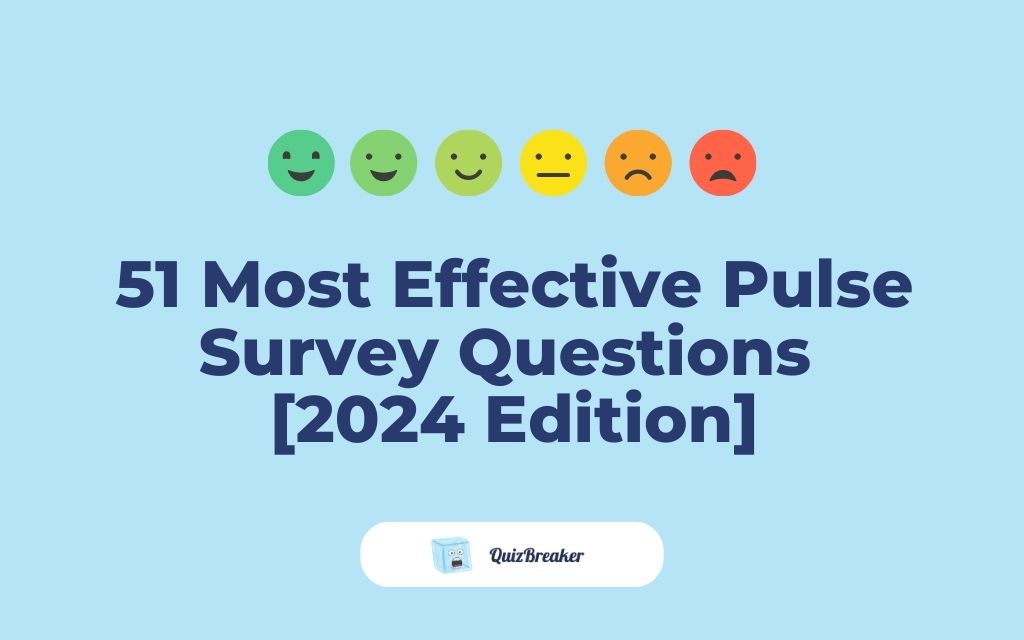
If you want to try it out, we’ll help you create an effective pulse survey so you get the most reliable results and see where your company stands in terms of employee engagement and other important metrics.
There's a lot of work that goes into crafting these surveys, starting with asking the right questions. Without further ado, we introduce the 51 most effective pulse survey questions, organized into the following 5 categories and the best practices attached with implementing them in your organization.
1. Yes/No Pulse Survey Questions
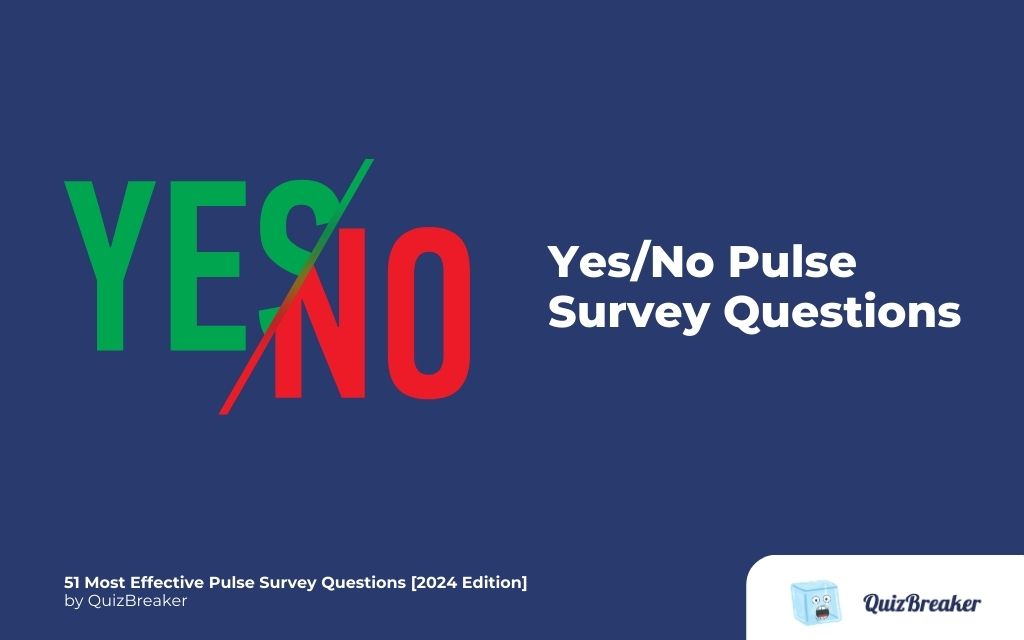
Yes/No questions are fairly common for pulse survey questions. Although many argue that they’re very simple and can’t always provide valuable insights and help respondents share valuable information, they’re handy, concise, and don’t intimidate respondents.
That’s why we feel you can benefit from including them in your pulse surveys. Plus, chances are you’ll insert other kinds of questions too, so annual engagement surveys will end up being quite versatile anyway.
Now onto the sample employee engagement pulse survey questions for this category.
-
Do you think your job workload affects you even when you leave the office?
-
Do you ever find yourself thinking about work during weekends?
-
If you have any personal problems, do you let the leadership team know?
-
Do you have access to everything you need to perform to the best of your ability at work?
-
Would you say you receive useful employee feedback on a regular basis for the work you do?
-
In general, do you consider your company a great place to work in?
-
Do you feel comfortable sharing your opinions and thoughts with your peers?
-
Are your personal goals a match to the goals of the company you work for?
-
Do you know what it takes for you to further improve your skills within your current job position?
-
Do you think your supervisor cares about you as a person (not just as an employee)?
2. “On a Scale of 1-10” Questions
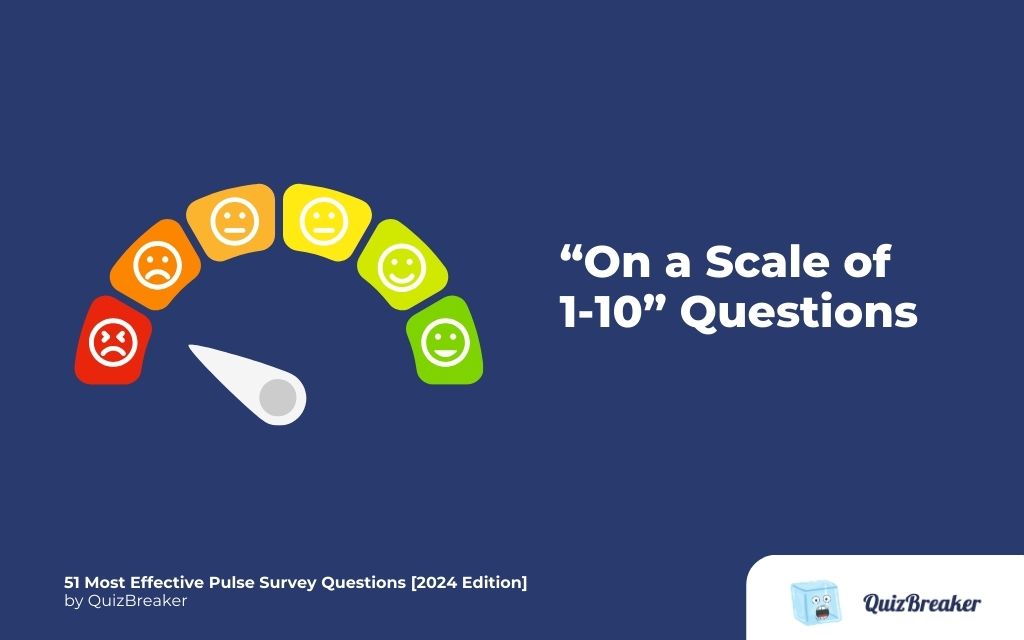
Asking people to rank “things” on a scale of 1 to 10 is a fairly common practice. Asking your employees to do the same when they take a pulse survey is a great way to see where they stand on different matters.
The idea behind this is simple - the respondent should select a number that closely reflects their opinion about the question(s) being answered. This is a universally accepted type of survey assessment. One of the strengths of “On a Scale of 1-10” pulse survey questions is their simplicity. Regardless of your employees’ culture, background, understanding, position, and knowledge, you can bet they’ll all be able to answer these questions and interpret them correctly.
Plus, conducting statistical analyses is very easy with such numerical scales, so you’ll be able to analyze the results more accurately.
When it comes to the actual number scale, here’s what the numbers potentially stands for:
extremely good = 10
very good = 8
good = 6
not bad = 5
bad = 3
the worst = 0
In this category, here are some good questions you can ask your team.
-
On a scale of 1-10 (1 being the lowest, and 10 the highest), how would you rate your work-life balance?
-
On a scale of 1-10 (1 being the lowest, and 10 the highest), how pleasant would you say the environment you work in is?
-
On a scale of 1-10 (1 being the lowest, and 10 the highest), how professional would you say the behavior of your company’s managers is?
-
On a scale of 1-10 (1 being the lowest, and 10 the highest), how excited are you about your job?
-
On a scale of 1-10 (1 being the lowest, and 10 the highest), how innovative is the company you work for?
-
On a scale of 1-10 (1 being the lowest, and 10 the highest), how flexible are your managers regarding matters such as taking a day off?
-
On a scale of 1-10 (1 being the lowest, and 10 the highest), how productive are your work days?
-
On a scale of 1-10 (1 being the lowest, and 10 the highest), how would you rate the culture of the company you work for?
-
On a scale of 1-10 (1 being the lowest, and 10 the highest), how open-minded are your peers when it comes to changes, new ideas, and progress?
-
On a scale of 1-10 (1 being the lowest, and 10 the highest), how ambitious are you?
3. “How Likely” Questions
The “How likely” employee pulse survey questions are used to calculate the likelihood of employees doing something, or in other words, they’re there to prompt employees to think about how likely they’re to engage in something.
These questions typically contain three options (of course, this isn’t a set rule, they may be adjusted based on each pulse survey question’s needs): not likely, somewhat likely, and very likely.
They provide two opposing views, and a third option in the middle to balance them out.
- How likely are you to recommend your company’s products/services to a friend or a family member?
(1) Not likely; (2) Somewhat likely; (3) Very likely;
- How likely are you to search for another job?
(1) Not likely; (2) Somewhat likely; (3) Very likely;
- How likely are you to get promoted?
(1) Not likely; (2) Somewhat likely; (3) Very likely;
- How likely are you to form a close friendship with a colleague?
(1) Not likely; (2) Somewhat likely; (3) Very likely;
- How likely are you to take a leadership role in a group project at work?
(1) Not likely; (2) Somewhat likely; (3) Very likely;
- How likely are you to ask for help if you’re dealing with a client you can’t seem to put up with?
(1) Not likely; (2) Somewhat likely; (3) Very likely;
- How likely are you to achieve all your goals for this week?
(1) Not likely; (2) Somewhat likely; (3) Very likely;
- How likely is it for your new product/service ideas to be accepted at the next group meeting?
(1) Not likely; (2) Somewhat likely; (3) Very likely;
- How likely are you to give up on a task/project upon encountering the first obstacle?
(1) Not likely; (2) Somewhat likely; (3) Very likely;
- How likely are you to get bored with your current work routine in the foreseeable future?
(1) Not likely; (2) Somewhat likely; (3) Very likely;
4. Strongly Agree/Strongly Disagree Measurement Scale Questions
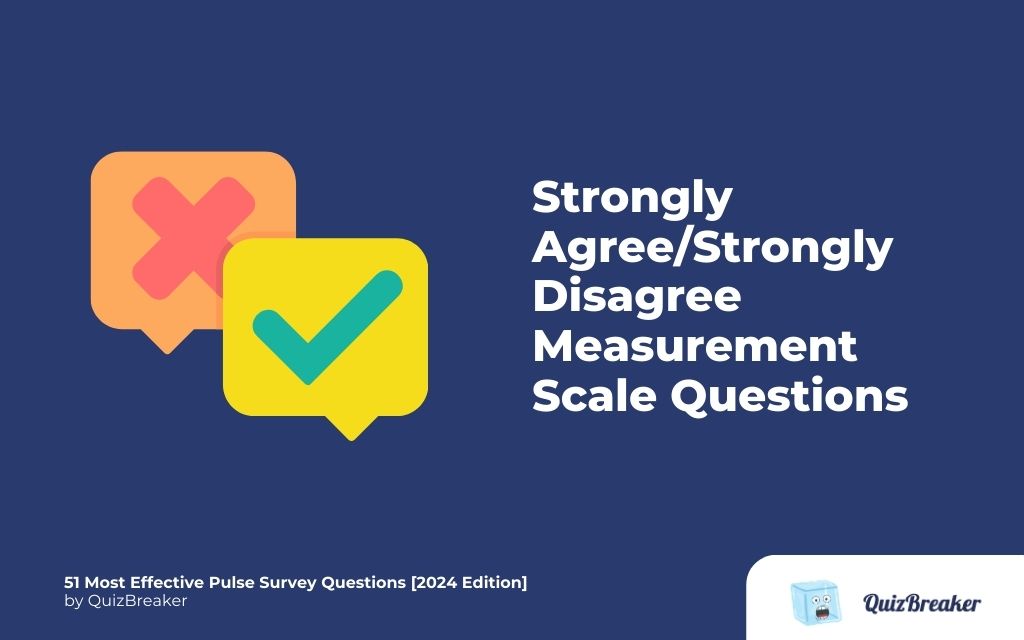
Pulse survey questions aren’t just about asking questions in the traditional sense of the word. In other words, it’s more than typical for pulse survey questions to include statements in their surveys and use a fixed measurement scale for answers, such as the 5-point Likert scale.
The Likert scale is very common in questionnaires and surveys - and if you’ve ever taken any survey, chances are you’ve come across it yourself. The main purpose behind the 5-point Likert scale is to illustrate responses from one extreme to the other (one extreme would be the “strongly agree” option, whereas the other is “strongly disagree”). This helps employers measure their employees’ attitudes and understand their (extreme) emotions better.
Moreover, using such a scale makes the survey results much more specific and measurable, so here are some questions that you can use.
- I’m aware of what’s expected of me at all times.
(1) Strongly disagree; (2) Disagree; (3) Neither agree nor disagree; (4) Agree; (5) Strongly agree
- My job responsibilities match my job position.
(1) Strongly disagree; (2) Disagree; (3) Neither agree nor disagree; (4) Agree; (5) Strongly agree
- My current salary corresponds to my work-related responsibilities.
(1) strongly disagree; (2) Disagree; (3) Neither agree nor disagree; (4) Agree; (5) Strongly agree
- I always know who to contact if I run into some trouble.
(1) Strongly disagree; (2) Disagree; (3) Neither agree nor disagree; (4) Agree; (5) Strongly agree
- I can implement everything I learned from training/coaching/mentoring sessions right away in my work.
(1) Strongly disagree; (2) Disagree; (3) Neither agree nor disagree; (4) Agree; (5) Strongly agree
- My current job is in alignment with the career I’ve envisioned for myself.
(1) Strongly disagree; (2) Disagree; (3) Neither agree nor disagree; (4) Agree; (5) Strongly agree
- This company allows me to grow professionally.
(1) Strongly disagree; (2) Disagree; (3) Neither agree nor disagree; (4) Agree; (5) Strongly agree
- I’m happy with the onboarding experience I had when I started working for this company.
(1) Strongly disagree; (2) Disagree; (3) Neither agree nor disagree; (4) Agree; (5) Strongly agree
- I think this company employs workers with high qualifications and relevant work experience.
(1) Strongly disagree; (2) Disagree; (3) Neither agree nor disagree; (4) Agree; (5) Strongly agree
- My immediate supervisor cares about my well-being and further progress in this company.
(1) Strongly disagree; (2) Disagree; (3) Neither agree nor disagree; (4) Agree; (5) Strongly agree
- I can always rely on my team members.
(1) Strongly disagree; (2) Disagree; (3) Neither agree nor disagree; (4) Agree; (5) Strongly agree
5. Ad Hoc Pulse Survey Questions
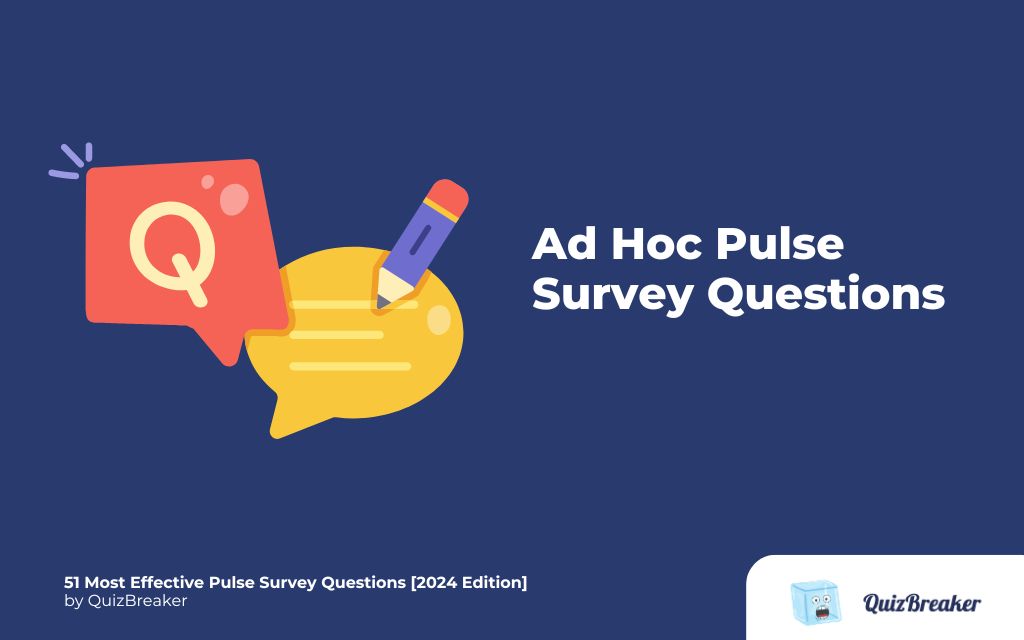
Your pulse survey questions don’t always need to follow a pattern or belong to a specific group. This applies both to the issue they revolve around (for instance, a group of questions dealing only with job satisfaction), or the way they’ve been formulated (“how likely” questions, “on a scale of 1-10 questions, and so on).
Sometimes, going freestyle gives the most accurate results, so feel free to include random questions in your pulse surveys if you see the need. This is actually something we actively encourage - it’s not a thing that should be done only sometimes.
Such an approach allows you to include many of the things you wish to ask your employees, however, you may not seem to find the “right” category.
Including ad hoc questions doesn’t require categorization or classification, so here are some ideas.
-
What’s one employee perk you wish to have?
-
Are you a fan of hybrid work?
-
If it were up to you, what changes would you make in the company you work for?
-
What day of the week do you feel the most productive?
-
What day of the week do you feel the least productive?
-
How often do you procrastinate?
-
What types of snacks would you like to see more in the office?
-
Are there any out-of-office activities you would like to participate in together with your peers?
-
On the whole, would you say that the company you work for is heading in the right direction?
-
How would you rate the engagement levels in the company you work for?
Frequently Asked Questions
What are pulse surveys?
Pulse surveys, as the name implies, are surveys that help employers feel the pulse of their organization. Put simply, it allows employers to understand ongoing trends in employee experiences, promote fast action, comprehend potential dangers of things going wrong, and so on.
Advantages
There are many advantages when it comes to implementing such types of engagement surveys in your business practice. First and foremost, pulse surveys help you measure (almost) real-time employee satisfaction and overall engagement. You get to receive feedback very frequently and assess the employees’ morale on the whole.
Pulse surveys may also boost the company’s culture and the employees’ positivity levels. A work environment where employees are often asked for feedback, how their projects are getting along, what their overall mood is like, and so on, is not only a professional work environment, but a very pleasant and friendly one as well.
Next, asking your employees about a specific subject week after week (that is, if you do such surveys on a weekly basis), helps them be even more committed to the subject at hand, and understand it from another perspective. For instance, let’s say you ask pulse survey questions about a new product/service you may launch - this will keep employees thinking about potential products/services in the upcoming period.
Pulse surveys also allow you to analyze and track certain developments over time. For instance, if you’ve been asking questions about some additional coaching/mentoring for employees, and you receive somewhat negative feedback, you’ll know this is an area that needs improvement. After you’ve done some changes, and you start noticing better answers on the pulse survey questions, you know you’ve done a good job with addressing your employees’ remarks and suggestions.
This benefit goes hand in hand with the ability to monitor both strengths and weaknesses within the company.
It’s worth mentioning that these surveys encourage open communication, too. Namely, it gives employees the freedom to state their views openly and quite frequently, without them needing to bring up certain subjects and issues.
In other words, they shouldn’t feel as though they need to come to you and initiate a discussion (which may be over a sensitive business topic or an ongoing issue in the office) if the pulse survey questions tackle them.
Disadvantages
If pulse surveys are sent out far too often, they might lose their overall purpose and effectiveness. When employees are asked to fill out forms, answer questions, and take surveys far more frequently than what’s feasible, they may end up putting less and less effort into them.
For instance, if your company opts for a weekly pulse (as we outlined above), and after a while, you come across vague answers and employees not willing to take the survey, you may realize that such a decision has created survey fatigue. We discuss pulse survey frequency in the next section, so that will give you an idea as to how to approach this matter.
Some employees may perceive pulse surveys as a great way to express themselves, their thoughts, and options, however, if you as an employer don’t pay attention to their response and overall feedback, your employees might be discouraged by the notion of pulse surveys.
Put simply, if several employees keep on saying they don’t see a way as to how they can make progress in this company, and their pulse survey responses reflect their requests, and you don’t take proper action to address this - they might feel as though their suggestions and pleas have been in vain, and that the surveys are nothing more than a formality.
Frequency
Finally, a lot of employers struggle to determine how frequently they should send out pulse surveys to their employees. Should it be done once a month? Once a week? Maybe it should become a daily thing?!
While we certainly don’t think pulse surveys should be a daily thing, we do believe that conducting them on a weekly or bi-weekly basis would be more or less acceptable or appropriate.
That said, there isn’t a one-size-fits-all approach, as each company has its own way of conducting surveys. So, certain employers may feel that once or twice a week is too much and they’d like to conduct such surveys once every three or four weeks.
The frequency of conducting pulse surveys largely depends on the other surveys your company tends to carry out, which brings us to the next question.
Should pulse surveys replace the well-known annual surveys?
Pulse surveys definitely shouldn’t replace annual surveys because both usually serve a different purpose and are done in different intervals. But we understand why certain employers believe they could/should be replaced.
Namely, pulse surveys are said to have a much higher response rate than annual employee surveys. This is so because they’re much shorter, easier to submit, and not as detailed and complex as annual surveys. These specifications go hand in hand with the claim that pulse surveys should replace annual surveys.
The traditional annual surveys, however, are much longer, they include a wide range of questions and topics and require bigger reflection and contemplation before answering them. Most of them are open-ended questions that require more expounding.
This means that employees should submit much longer and more detailed responses compared to the pulse survey questions. This may be what puts a lot of employees off of completing them too.
How should I choose pulse survey software?
Since you’re reading this article, chances are you’re considering introducing pulse survey software in your company. Or perhaps you’ve used one in the past, haven’t seen the results you were hoping to see, and now you’re on the lookout for a new one.
And with plenty of softwares out there, it’s certainly a tough call to make.
Still, there are some guidelines and things you can take into account to make an informed decision.
Accessibility across multiple devices
First of all, it’s useful to pick mobile-friendly pulse survey software. That way your employees can feel comfortable to take a survey using their phones or even tablet devices.
Therefore, making sure the software works well across a wide range of devices should be one of your top priorities when taking a pick. Now that we know that mobile apps have higher engagement rates than mobile-optimized websites or desktop web viewing, it’s only logical to assume that some of your employees will feel more comfortable to take the survey using their phones.
Also, ensuring the pulse survey software can be used on numerous devices prevents low response rates.
Customizable questions
Next, see whether the software allows for customizable questions or just a set of prepared questions. If you’re not a fan of one-size-fits-all questions, you’ll definitely want to consider software which allows you to insert your own questions, like the ones in this article.
This option should be available without any extra costs or complex setups.
Anonymous feedback
Then, check if the software provides anonymous feedback or each individual response comes with an employee’s name. Ideally, such surveys should be anonymous because employees need to feel free to express their thoughts in a safe manner.
Easy-to-read reports
Employers usually wish to receive understandable reports, too. If you need a lot of time to process the responses and understand the data, you’ll probably end up being more frustrated than properly informed about the survey’s results. This is why we tend to provide clients with very easy-to-read reports, so that you understand how your team feels quickly and easily.
User-friendly interface
Let’s not forget the importance of a user-friendly interface, too. If you find the software’s interface to be confusing and very technical, why would you employees think otherwise? You don’t want to frustrate your employees - you wish to provide them with an enjoyable survey-taking experience.
Budget
You need to pay attention to your budget as well. You’ll notice that most pulse survey software tends to offer different prices depending on the number of users (employees). Some even offer a low monthly fee, and then as time goes by, the price increases. Or they might have some lock-in contracts. At QuizBreaker, we don’t do that and our pricing is very straightforward. If you visit our website, you’ll see that our price is the same irrespective of how big your team is.
Additional features
You may wish to check for any additional features. For instance, certain software tends to provide clients with extra services, such as employee recognition features, which is a great way of showing your employees you care and you acknowledge their efforts.
Business needs
Finally, don’t forget to take into consideration your overall business needs. Analyze how frequently you’d use this software, how comfortable your current employees are with this way of digital survey-taking, and so on. Being prepared beforehand with many aspects of the pulse survey process will help you make the right choice not only for your company, but for your employees as well.
Final Words
All in all, pulse surveys are a great way to see current team sentiment and understand ongoing tasks, explore where your company is headed, and stimulate workers to reflect on their everyday thoughts.
We hope our article helped you understand the importance of such surveys, and that it gave you an idea about the types of questions you should include in your next pulse survey (or your first one, in case you haven’t done any so far).
In any case, have fun conducting it!
Further Reading



